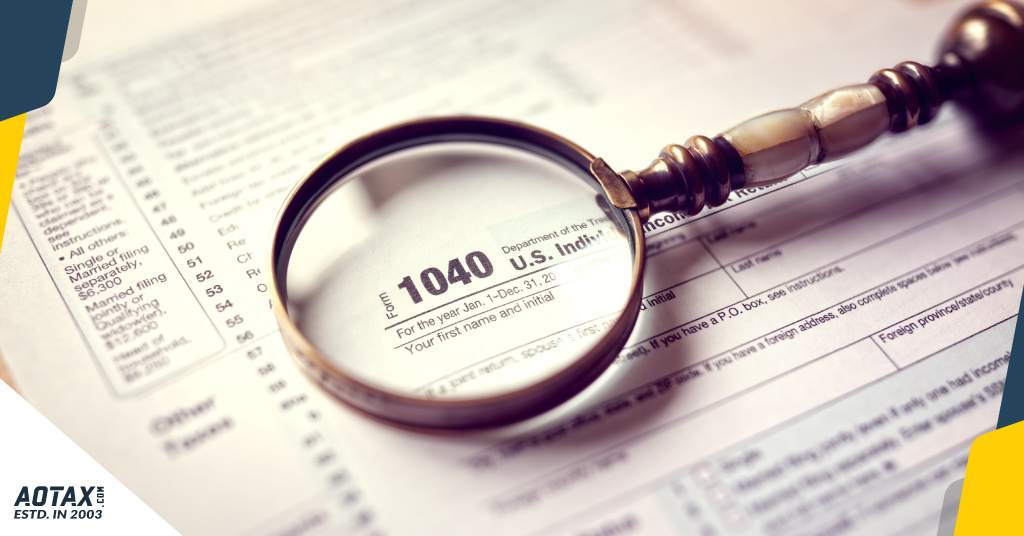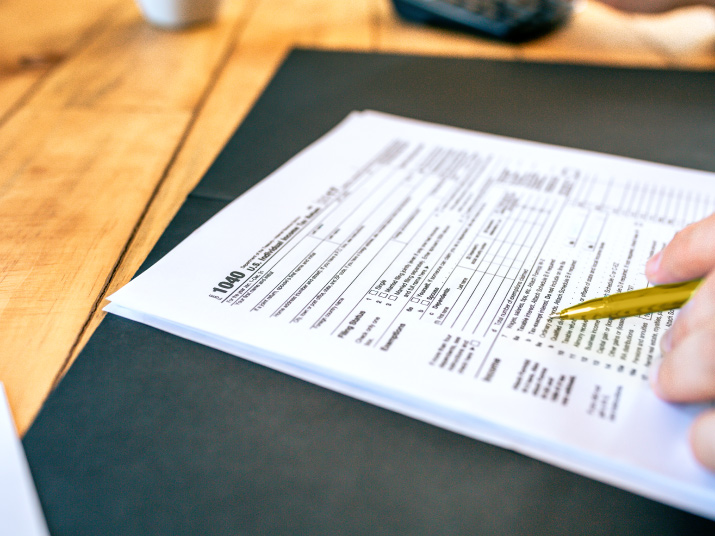


Personal Income Tax Return Form Correction and Changes You Should Know About
Tax filing season is arguably the most nerve-wracking time: battling documents, figures, and important dates is an all-consuming task. In addition, filing your taxes demands a constant awareness of your finances, tax strategy, and IRS regulations.
A change in one could significantly impact the rest, and this is undoubtedly true for changes that the Internal Revenue Service (IRS) often implements through tax season.
Changes in laws, policies and tax forms can throw your preparation off track. Unfortunately, we’ve seen multiple instances of the same over the last few years due to Covid-19 and the bills passed to alleviate its effects.
However beneficial or necessary, these changes leave taxpayers like you scratching their heads while trying to make sense of these amendments and additions.
No one likes to be caught off-guard, and certainly even less so by the IRS. So we’ve compiled a list of changes you can expect to see on this year’s forms, so you can be prepared to optimize your tax bills.
So, What’s New This Year in Personal Income Tax Return?
Taxpayers can expect to see various changes on their tax forms for the last financial year, especially regarding deductions and credits. Keep reading to know more.
Form 1040 and its schedules

This year’s Form 1040 is far from compact, with Schedules 1,2, and 3 all having expanded to take up close to two pages each. This elongation is due to additions to income and extra taxes, each getting their sections instead of being grouped into one confusing bundle. Additionally, there are many changes related to credits and deductions that we’ll discuss below in more detail.
Recommended reading: First-Time Taxpayer? 12 Tax Credits and Deductions You’re Eligible For
Credits
Child tax credits
Lines 19 and 28 on Page 2 of Form 1040 were adjusted to account for changes made to the credit and consider that it was fully refundable for 2021.
Earlier, the credit was only partially refundable (up to $1,400 per child) and was only applicable for children 16 years and younger (now, parents can claim the credit for 17-year-olds).
Earned income tax credits
The Earned Income Tax Credit was upgraded due to changes in the American Rescue Plan Act. Most importantly, the Credit now allows more childless taxpayers to claim the credit.
The age limit has also been increased to allow people aged 19 to 65 to claim the credit on their 2021 tax returns. Line 27 of Form 1040 has been modified and expanded to accommodate these changes.
Recovery rebate credits
In 2020, the Recovery Rebate Credit on Form 1040 was meant for people who didn’t receive their first and/or second check or those who received an incorrect amount.
For 2021 however, it must be noted that the credit is only for those who did not receive their third check or for those who didn’t receive the entire amount. Therefore, taxpayers must lower their credit claims to account for this.
Savers credits
The Savers Credit aims to encourage lower and middle-income taxpayers to save for their retirements. The credit was allowed for 10%, 20%, or 50% of the first $2000 saved, depending on income and filing status. However, for the 2021 tax return, taxpayers can claim a 50% credit if their AGI is $19,750 or less. Form 1040 considers this.
Deductions

Standard deductions
Due to adjustments for inflation, the deductions that taxpayers can claim are much higher and are reflected on your tax forms. The increments to the 2020 amounts are as follows:
- $300 extra for married couples filing jointly
- $1,350 per spouse for couples over the age of 65
- $150 extra for single filers, $200 for those over 65
- $150 for head-of-household filers
Charitable deductions
Earlier, deductions claimed for any charitable donations would affect taxpayers’ AGIs. This is no longer the case, and the space allowing you to check the $300 charitable contribution option has been moved elsewhere in the form.
Additionally, married couples can now individually claim deductions instead of being counted as one entity. That means that married couples can claim up to $600 in deductions for donations.
Tax brackets
The tax brackets from 2020 remain the same, but the income ranges that fall into them change. This determines the amount of tax you pay, so check where you fall wisely.
You can then appropriately complete line 15 on Form 1040 pertaining to taxable income.
Taxes for the self-employed
The tax breaks that self-employed taxpayers can take have been tweaked and include:
- Deductions of up to 100% for business meals (to be claimed on Line 24b, Schedule C).
- Long-term care insurance premiums do not have to be itemized and can be deducted on Line 17, Schedule 1.
Unemployment benefits
An unemployment compensation benefit worth $10,200 was in effect from 2020 but no longer. Therefore, any compensation earned in 2021 will be fully taxed in the upcoming tax return season. The same must be mentioned on Line 7, Schedule 1 of Form 1040.
Student loan discharges
Students with undergraduate and graduate student loans no longer worry about the forgiven student debt being a part of their taxable income. Earlier, this amount had to report on Line 8c, Schedule 1, but now this can be left blank.
Next Steps
The best thing taxpayers can do at the moment is to take stock of how these changes affect their filing statuses and strategies and then prepare their documents accordingly.
However, the complexity of filing your taxes cannot be understated, and often the best thing to do is to hire a tax professional to help. With close to two decades of helping Indians in the US prepare for, and file their tax returns, AOTAX is the best. We can help you get everything in order and ensure that your tax forms are error-free. Sign up for free today!

Which of THESE Tax Filing Methods Is the Most Convenient for You?
As tax season nears, you may ask what the alternatives available for filing a tax return are. You have three options to file your tax: filing your taxes, filing using online tax software, or filing by hiring a professional. You must have certain information readily available when filing taxes, no matter which method you select. This article will see how to file your taxes, which options are available, and which tax filing methods are best. But before you start to look for ways to file your taxes, you must know:
Do you even have to file taxes this year?

Your income, tax filing status, age, and other criteria will determine whether you must submit a tax return this year. It also depends on whether or not you can be claimed as a tax dependent by someone else.
Even if you aren’t required to file taxes, you should consider doing so anyway: If you qualify for certain tax credits or have already paid some federal income tax, the IRS might owe you a refund that you can only get by filing a return.
Therefore, give filing tax a serious thought if:
- Your paychecks had income tax withheld.
- You paid estimated taxes or had a refund applied to this year’s estimated tax from the previous year.
- Certain tax credits are available to you.
When is the 2022 tax season?
In the early months of the following year, “tax season” for the previous tax year begins. For example, the Internal Revenue Service (IRS) will begin receiving and processing returns for the 2021 tax year on January 24, 2022. Also, due to some public holidays in certain states/districts, the deadline for filing taxes is April 19, 2022.
Choose How to File Your Taxes

You can file your taxes in several ways. Hiring the service of a tax professional, using online tax software, or filling out the forms yourself are the three primary options for tax preparation. Take a closer look at these methods below:
1. Filing taxes online with tax software
You already know how to prepare and file taxes online if you’ve used tax software in the past. Many big tax software companies also provide access to human tax preparers.
For example, some companies provide software or support packages that include on-demand, on-screen, or online access to human tax specialists who can answer questions, evaluate your return, and even file your taxes.
Several tax-preparation companies, including big brands, offer free online tax preparation software under the IRS Free File program. You must have an adjusted gross income of $73,000 or less to be eligible.
2. Hire and work with a tax preparer
With a complicated federal tax code that is more than 74,000 pages long, it’s no surprise that more than half of all taxpayers in the United States need a professional to assist them.
If you choose this method, make sure the tax preparer has a Preparer Tax Identification Number (PTIN) from the IRS, and also ensure you ask about the fees upfront. Please note that the IRS requires your tax return to be filed electronically if your tax preparer submits 10 or more returns in a year.
If you do not wish to meet in person with the tax preparer, in that case, there is another way of filing taxes. You can share documents electronically with a tax preparer via a secure channel. Typically, the preparer will send you a link to the portal, where you will create a password and then submit photos or PDFs of your tax documents.
3. Filing taxes on your own
You can file taxes on your own by downloading and printing the forms from the IRS website, then mailing them with a check if you owe taxes.
Another option is filling out the forms online and submitting the return with a credit card payment. Using the Forms, Instructions, and Publications Search engine, you can find all the federal tax forms. In addition, state income tax forms are usually available on your state’s official website.
There is no cost or fee associated with submitting your taxes. Filing taxes on your own helps you understand and know your financial situation since it compels you to monitor and keep track of your transactions, earnings, and spending.
The majority of people who file taxes on their own have a simple tax status, an unaltered tax situation, or a genuine interest in the topic. If you have the necessary forms on hand, it can take only a few minutes.
If you file a paper return, it can take six to eight weeks to obtain your refund, however, you must submit it by mail in the below cases:
- You’re married and live in a community property state but filing a separate return.
- Claiming a dependent who has been claimed by somebody else.
- Submitting a tax form that cannot be electronically filed (like a multiple support agreement).
- Filing taxes after/before the e-file window.
Gather Tax Filing Information
Whether you hire a tax preparer or prefer filing taxes on your own, you’ll need to gather tax filing information.
The purpose is to collect proof of income, expenses that may be tax-deductible or qualify you for a tax credit, and documentation of taxes paid during the year.
A tax preparation checklist offers more details, but here’s a quick rundown of what you’ll need:
- Social Security numbers for yourself, your spouse, and any dependents, if applicable.
- W-2 form, showing how much you earned in the past year and how much taxes you have already paid. (If you worked multiple jobs, you may have received multiple W-2 forms).
- 1099 forms, record money given or paid by someone other than your employer. That is non-employment income such as dividend income, interest income, etc.
- Contributions to a retirement account
- Mortgage interest and property taxes
- Donations to charity
- Local and state taxes you paid
- Expenses related to education
- Medical bills that have not been reimbursed
- Federal and state tax returns from the previous year
Collect Income Data
Getting your tax forms together for you and your spouse is a great start, however, keep in mind that you may have income that isn’t listed on your W-2. Remember to include any income you received over the year, such as:
- Money earned through investments
- Rental properties
- Home businesses
- Winnings from the lottery or a casino
Itemized Deductions and Credits
The total amount of taxable income is reduced due to tax deductions. Hence, keeping track of everything you can deduct is necessary. The following are some common deductions:
- Child care costs
- Education costs
- Interest payments on a mortgage
- Donations to charity
Most deductions necessitate receipts and other documents, so double-check with your tax expert to ensure you have all you need.
Track of Taxes Paid
Most businesses deduct federal, state, and additional taxes from each employee’s pay. On your W-2 form, these deductions will be detailed. You’ll have to keep your tax records if you’re a contract employee or operate a business.
Significant Life Changes
Important life events might have an impact on your tax return. If you had a life event that the IRS recognized, you may be able to claim additional deductions, such as:
- Divorced
- Got married
- Had a baby
- Moved to a new state
Closing Thoughts
The federal tax code is constantly changing. Make sure you discuss how these changes may affect you each year with your tax expert. Proposed tax legislation may have an impact on those in higher tax bands. Make sure you understand these bills significantly if your family’s annual income surpasses $250,000.
With over 15 years of experience, AOTAX is the experienced team you need. AOTAX has managed the finances of a number of Indian IT professionals. We have aided in reducing tax burdens and simplifying tax preparation year-round. So, if you’re going to trust a pro, sign up for free with AOTAX today!

Most Effective Ways to Overcome Problems of Filing as a Sole Proprietor
With less than a month to go before the tax filing deadline, taxpayers are steeling themselves for last-minute changes, checks, and balances.
One group of individuals in particular always tend to be groping in the dark when it comes to tax return season. Given the fluidity of their situation, sole proprietors often face many challenges while preparing their tax documents.
Sure, the perks of being your boss are fantastic, but the downsides can be pretty nasty if you’re not well-versed in the taxation side of things. Below, we explore some common problems sole proprietors can face while filing their tax returns and how to overcome them. Read on to know more about the mistakes you should avoid and work around them.
Who are Sole Proprietors?

Before we dive into what they could potentially do wrong, let’s first look into who precisely sole proprietors are and what filing as a sole proprietor entails.
To begin with, sole proprietorships are one of the most common business structures in the US, owing to their flexible structure and potential for easy establishment.
Essentially, there is no difference between the individual and the business for taxation purposes: The IRS considers the business owner a legal business entity and an individual.
Individuals can receive the entirety of their business profits but are also equally liable for all debt and expenses incurred by the business. Business income passes through the business to the business owner, who then reports on their tax returns. This drastically reduces paperwork but can often complicate matters if figures are not declared correctly.
Additionally, sole proprietors are likely to be individuals whose professions allow them to either work remotely or require traveling to customers.
This entity is typically devoid of the traditional ‘brick-and-mortar’ structure. Typical professions that may fall under sole proprietorship include:
- Professional cleaners/organizers
- Home healthcare service providers
- Freelancers (content creators, photographers, web developers, etc.)
- Business consultants or public speakers
What Problems Do Sole Proprietors Face?

Sole proprietors have to be extra careful about handling tax obligations, especially since the consequences could be an IRS audit or simply leaving money on the table.
Common issues include:
1. High tax bills and low refunds
Most self-employed taxpayers tend to lose out on sizable refunds and the opportunity to lower their tax bills. This is simply because sole proprietors are unaware of the deductible expenses they can claim against their income.
Running one’s own business can be challenging enough, so having to pay hefty tax bills shouldn’t be another burden that sole proprietors take on.
It is advisable to keep accurate and detailed records of all expenditures and maintain separate checkbooks for business and individual purchases. Doing so can simplify providing proof of deductible expenses and significantly lower one’s taxable income.
Common deductible expenses include:
Start-up costs: includes operational costs and expenses incurred to get the business up and running, such as repairs, advertising, and purchasing supplies.
Transport and automobile costs: money spent on keeping a vehicle roadworthy, especially helpful if one’s business is dependent on traveling by cars, such as bakery and parcel-delivery businesses.
Insurance premiums: expenses incurred while covering oneself and one’s workspace from possible losses.
Legal and professional fees: money spent on hiring financial and legal consultants for their expertise in the field.
Educational fees: particularly useful for business owners that have attended classes that foster professional development in their field.
2. Increased risk of penalty charges
No taxpayer wants trouble with the law, especially not with the IRS regarding taxation and discrepancies in the amounts filed.
Sole proprietors are exposed to a higher risk of paying penalty fees since other taxes must be paid over and above income and personal taxes.
Being aware of these taxes and their payment deadlines is critical to keeping everything kosher in tax documentation.
Sole proprietors should watch out for the following taxes:
Federal and State estimated taxes: sole proprietors are responsible for estimating their annual tax bill for all income earned and making quarterly payments to the IRS.
Federal and State income taxes: sole proprietors must accurately declare all business profits and losses and any other personal income. Business owners should be aware that their tax bracket is decided based on both personal and business income and must be prepared to pay taxes accordingly.
Self-employment taxes: sole proprietors needn’t wait for traditional employers to withhold portions of their income for FICA contributions. Instead, they should be making these Medicare and Social Service contributions while paying their taxes.
3. Delays in refunds & problems with incomplete tax documents
It’s no secret that backlogs inundate the IRS, but processing times are worsened by a lack of ‘open and shut cases. In addition, going back and forth with taxpayers about errors in their forms, missing documents, and invalid proofs makes life difficult for both parties.
To ensure that you present a textbook tax filing case, you must submit all required forms and documents and triple-check every information you’ve provided—right down to crossing your I’s and dotting your T’s. Silly errors and forgetfulness can delay refunds, which can be avoided by being well-prepared.
Sole proprietors must submit the following documents:
- Schedule SE: must be submitted if your business earned more than $400 worth of revenue
- Form 1040, Schedule C: provides details about business income, expenses, and inventory.
- All other documents are required for your income tax filing.
Also read: How to File an IRS Form 1040: A Step-Wise Guide
How Can AOTAX Help You And Your Business?
With close to 20 years in the business of helping Indian residents in the US file their taxes effortlessly, AOTAX is primed to answer all your questions and get you the best return possible.
We make sure you consult with some of the best tax professionals in the business to help you plan and prepare for tax season without worrying about a possible audit from the IRS.
If you’re looking for a stress-free tax submission, sign up for free with us today!

8 Mistakes to Avoid When Filing as a Sole Proprietor
Being the owner of a small business is an exciting experience. You are the captain of your ship, and you have complete control over when and how you set sail.
However, as the April 15 tax deadline approaches, your confidence may fade, given the unfamiliarity with US tax laws. As a result, filing your taxes as an Indian who owns a sole proprietorship in the United States might be stressful.
This article will show you how to avoid such eight blunders while filing as a sole proprietor and do your taxes swiftly.
Who is a Sole Proprietor?

A sole proprietor is an individual who owns and operates their own business. For instance, you are a sole proprietor if you work as a freelance writer. However, you must obtain the necessary licenses and permits by industry standards. Your business income is your income, and you are responsible for paying taxes.
Recommended: What Indians in the States Should Know About Filing as a Sole Proprietor – AOTAX.COM
Eight Pitfalls to Avoid While Filing as a Sole Proprietor

If you are a sole proprietor, you’ll need Form 1040 to pay your taxes and declare your earnings on Schedule C. Self-filing taxes might be intimidating. However, it’s much more daunting if you file as a sole proprietor.
We have compiled a list of eight common blunders sole proprietors make while filing taxes:
1) Ignoring quarterly tax payments
In the United States, businesses must pay estimated taxes every quarter. The IRS will penalize you if you wait until April 15 to pay the taxes in full.
As a result, it is more prudent to account for your profit and loss and pay your taxes every quarter. You can withhold a portion of your business income as taxes each month and send the IRS a quarterly tax payment.
2) Failure to meet tax deadlines
If you fail to pay your taxes on time, you will be subject to a penalty of 5% of your monthly taxable income. Furthermore, the IRS has the authority to fine you up to 25% of your total tax bill.
They can also charge you a 0.5% late fee for each month you don’t pay after the deadline. Request a personal tax extension if you are unable to meet the deadline. However, you must pay a portion of the outstanding balance by the initial date.
3) Cheating on your tax bills
According to an IRS survey of 2001, sole entrepreneurs underreported $68.5 billion in business income. As a result, you must provide an accurate tax estimate while filing as a sole proprietor.
If you earned more than $600 in the current fiscal year, the company that paid you is obligated to send you a 1099-MISC form and your paycheck.
They also provide a copy of the same to the Internal Revenue Service. As a result, you must accurately disclose your earnings to the IRS. Even if you don’t receive the 1099-MISC from the client or if it’s incomplete, make sure it’s updated before the tax deadline.
4) Failing to claim home office deductions
You are eligible for home office deductions while filing as a sole proprietor if you work from home. You can work from home in an office or a designated place.
Many business owners are hesitant to take advantage of this tax break. However, if you file as a sole proprietor, you can claim this deduction and save money on your taxes.
The IRS uses two formulas to compute the deduction amount: standard and simplified. Keep track of electricity bills, repairs, and other expenses for the standard deduction.
You can also claim $5 per square foot using the simplified formula. Therefore, the most you can receive for a 300 square foot home office is $1500.
5) Failing to claim deductions for business gifts
The gifts you offer your clients for branding purposes can help you save money on taxes. A $25 per person business gift deduction is allowed under the tax laws.
As a result, if you claimed $1000 in this category, including receipts and proof that the gifts were given to the required number of persons, you’re up for a rebate.
6) Confusing equipment and supply deductions
Business supplies include pens, paper, printer ink, notepads, etc. Equipment includes computers, software, and office furniture. Supplies should be reported on Schedule C, and equipment should be listed on a separate form 4562.
The IRS may not consider a deduction if you record supplies as equipment or vice versa. Furthermore, you can deduct the total cost of the equipment in one go. Alternatively, you might claim a portion of it each year.
7) Failure to track your expenses
If you keep track of every dollar you spend on your business, you can claim some of it as a deduction from the IRS. Hence, keep receipts and documentation to back them up.
For example, you can deduct not only your phone bills and travel insurance premiums but also web hosting, online courses, educational materials, and so on.
Thus, instead of scrambling to find receipts right before April, make it a practice to file them and keep track of your expenses.
8) Registering your firm as a wrong entity
If you end up paying more taxes as a sole proprietor, it’s wiser to change your business entity to an S-corporation. Similarly, if it lowers your tax burden, you can choose an LLC or C-corporation. Always consult your CPA or tax professional before making a decision.
Hence, by filing as a sole proprietor in the United States, you can take advantage of over 28 tax deductions. You can also put your tax savings to good use and go for business expansion.
If the IRS comes knocking on your door, prepare the necessary receipts and documentation to back them up. If you correct the aforementioned errors, you may soon find yourself staring at a sizable return.
Recommended: 14 Tax Breaks for Filing as Self-Employed NRI in the US – AOTAX.COM
Contact AOTAX if you are an Indian business owner wishing to file taxes as a sole proprietor. Over 2 million Indians have benefited from our assistance, at AOTAX, in filing their taxes on time.
Our tax planners and advisors will ensure that you get the most out of your tax returns and never miss a tax deadline.

Recent Comments